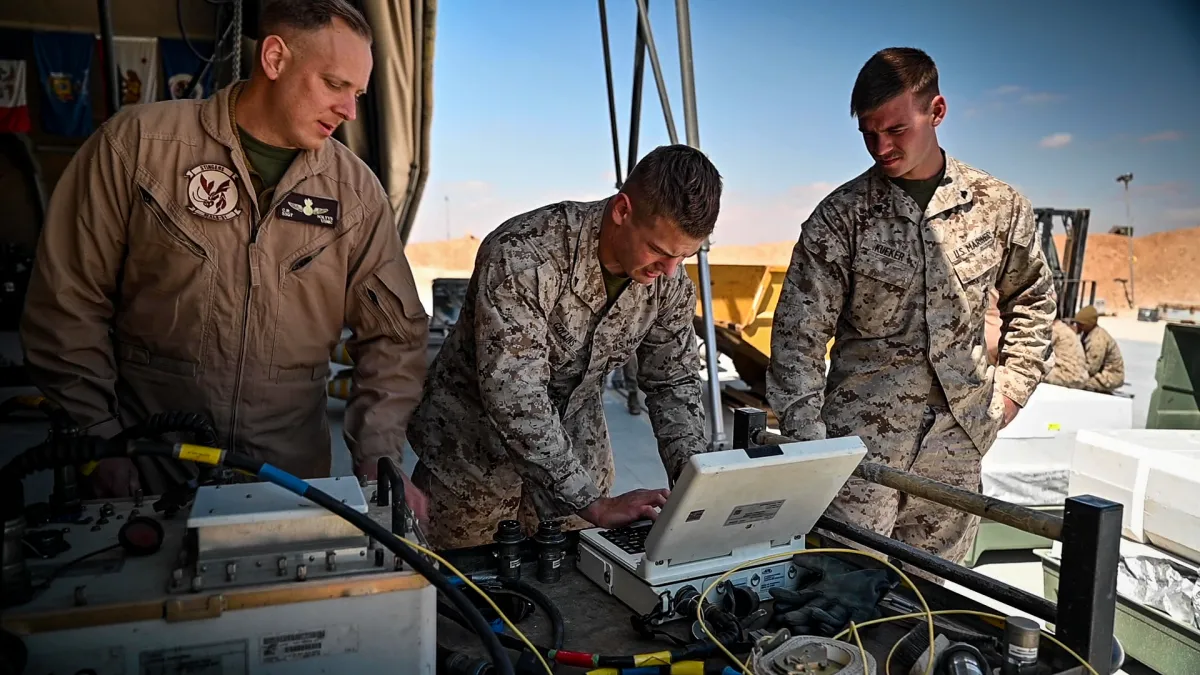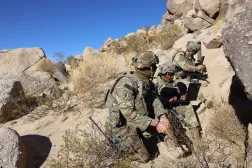New Marine Corps Information Command fleshing out command and control relationships

Following a series of exercises to test its structures, one of the big early lessons for the Marine Corps’ relatively new information command is figuring out how a variety of like-entities coordinate and collaborate.
Established in early 2023, MCIC is designed to more tightly link the service’s information forces — including cyber, intelligence and space — in theater with the broader joint force.
The organization’s commander, currently Maj. Gen. Joseph Matos, holds many roles, to include:
- Marine Corps Forces Cyberspace Command commander.
- Joint Force Headquarters-Cyber Marine Corps commander, the Cyber Command service component that conducts operations for other combatant commands, in this case, for Special Operations Command.
- Joint Task Force Ares commander, originally the counter-ISIS cyber task force but now is focused on nation-state activity, primarily, China.
- The service cryptologic component commander, the service organization for the National Security Agency.
- Marine Corps Forces Space Command commander.
The forces under these six hats are all uniquely assigned with many belonging to Cybercom, Space Command and NSA, but coordinating their relationships under a new construct has proven challenging.
“Those relationships were all known and understood a year and a half ago when we set up the command, but how those things could come together functionally, legally, policy-wise has been a learning point,” Col. Benjamin Grass, director of operations for the MCIC, MARFORCYBER and MARFORSPACE, told DefenseScoop in an interview. “How do you command and control that organization? Do all of those entities come together for convergence at the two-star general who commands all those, or is there an entity below that that can coordinate and direct, task, if you will? Those are the conversations that we’re having.”
Experimentation took place primarily in the Pacific region. When forces participated in these simulations or were requested for an operation, MCIC had to work through support that spanned multiple combatant commands — Indo-Pacific Command and Cybercom, for example – and through the service itself.
Grass said they’re still learning how best to do this, adding he’s been talking with the lawyers regarding policy and what forces can legally do from an authorities standpoint — especially when it comes to questions on whether a service-retained capability can be used or an authority from higher levels of government should be used.
“Those are some of the learning points over the past year that we’ve looked at and talked about in trying to use the different processes, because NSA has a process for assignment and request, Cybercom has a process, the service and the joint force have a process,” Grass said. “Working through those, learning those, testing those out, have been some of the things that we’re learning and talking through now.”
Another pertinent command-and-control conundrum the team is pondering is the relationship between space and cyber forces. In the Marine Corps, those forces sit under the same commander — albeit technically belonging to Spacecom and Cybercom, respectively — but the coordination of those forces wasn’t done at the operational level or in some cases at the tactical level. They were planning or operating in silos and integration didn’t always happen.
“Earlier this week, we talked about an exercise that from across a variety of [the commander’s] hats, it kind of bubbled up that all these forces were providing support in a variety of shapes, forms or fashions — that they had been planning, doing great work forwarded support in a variety of different commands, but we hadn’t looked at it holistically across the commands,” Grass said.
Exercises to operations
Grass explained that last year was all about exercising MCIC, but in 2024, officials have been looking at focusing more on incorporating into operations.
In a recent real-world example, planning staff was sent to aid Marine Corps Forces Central Command as they are looking to support Centcom in the Israel-Hamas conflict. Given those planners weren’t organic to the MARCENT staff, MARFORCYBER/MCIC surged planners to help, though they weren’t directly involved in executing operations.
Augmenting staff in commands around the world is one critical element MCIC is looking to improve upon.
“What we’re looking to do is build out some capabilities to push forward in support of those MARFORs,” Grass said at the Modern Day Marine conference in April. “What we’re trying to do is build out contingents that can go out and augment those staffs with maybe some forward support or dedicated reach-back support to go out and do some staff augmentation.”
MCIC and all the other associated commands have Marines with specialties that don’t exist anywhere else, so sharing that elsewhere can help augment planning for unique operations.
“If you haven’t been assigned to Spacecom, if you haven’t been assigned to Cybercom, maybe you don’t know and understand some of the unique nuances of getting access to those authorities,” Grass said. “Trying to augment those staffs with folks from across that enterprise, whereas historically, the Marine Corps had been, ‘Hey, this is what we need to do on behalf of Cybercom, this is what we need to do on behalf of Spacecom.’ Trying to bring all those together on behalf of a particular MARFOR is an example I’m talking to right now.”
Visualizing the invisible information space
One of the biggest demand signals Grass is hearing from the larger community is the need for battlespace awareness in the information world.
“We generally have focused on battlespace awareness and creating a common operational picture of ground forces that maneuver around, and we’ve done the same thing for aviation resources that are moving around,” Grass said. “More and more there’s a demand signal for information environment battlespace awareness, both where are our forces physically — as we deploy them or as they are used in an exercise — but also where are they in cyberspace or in actual space? There’s an increasing demand signal from commanders and from organizations.”
Officials in the past have talked about the need for a common operational picture in the information space to be able to better visualize forces and effects and direct them much in the way that physical forces are commanded.
One of the things MCIC has been looking to provide is how to present the non-kinetic forces both offensively and defensively under a single commanding general to help Fleet Marine Force commanders understand what their capabilities are.
They’re also working on training, specifically modeling and simulation of the information space to better understand the effects of particular information capabilities or tools.
The effects of a munition, which have a predictable blast radius, are well known. However, the impact of using an information capability to affect the mind of a target is less understood.
“In the Marine Corps, breaking things and blowing things up has been our mantra for 200-plus years at this point. How do we in this new world where information is that much more important — it’s a force multiplier as we look at the Russia-Ukraine crisis, as we look at the Israel-Gaza crisis — how do we incorporate that into our training?” Grass said. “We as Marines trained on the rifle range every year. We train in the gas chamber every year. We do our physical fitness training to know and understand how we’ll do that in a real environment. The information environment [is] a little different, a lot more challenging, if you will, to train in.”
There has been work ongoing in collaboration with Twentynine Palms to better incorporate information into training and exercises.
“As we, across the Marine Corps, build out our information occupations in the weeks and months and years ahead and we build that capacity, how do we ensure that that’s incorporated into the training that we’ve done? How do we develop a range, an information range where you can test messages?” Grass said. “I would love to have a range where I could push [an] article out into a virtual training range ahead of time where there’s a population that’s been modeled to, [and] I can run a simulation so I can see the reaction to his article before it goes out into the wild, if you will. How can I put that into a simulation to see what impacts might or might not happen?”
Commanders and units have to be comfortable with and understand these types of capabilities before firing what Grass called “information bullets” into the battlespace.
“The information environment, battlespace awareness, we’re continuing to work on that and push that as we go forward, developing and maturing … finding processes and procedures that work, finding partners that want that information … that realize there’s a demand signal for that information,” Grass said. “Those are probably the three focus areas, I think, that we’ll be spending time and effort on over the next probably 12 months.”






